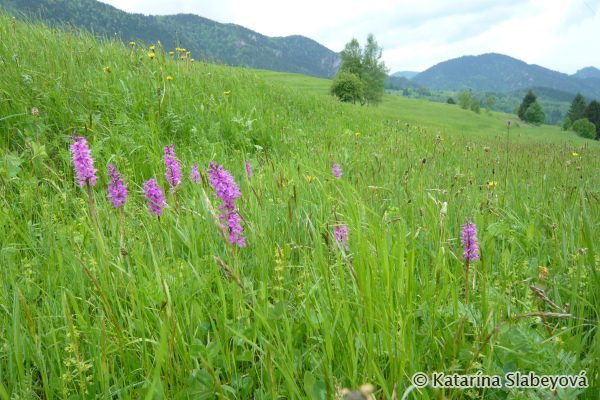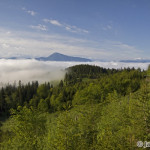100 species and no more, because the guide wants to have his beer
Tuesday – Thursday, May 21 – 23, 2013
Last week we set off to Orava, region in the northern Slovakia at the border with Poland, to a 3-day birding trip.
Every time we go on a birding trip, in the beginning each participant makes an estimate of how many bird species are we going to see during our trip. This time the numbers were very close to each other: 100, 101 and 102 bird species.
DAY 1
On our route we have made a short stop at Dubnické štrkovisko gravel pit, which lies only a few meters from main Slovak highway. It is a Special Protection Area designated as the most important breeding site for Common Terns in Slovakia. At this time of the year it teemed with birdlife. Apart from nesting Common Terns and gulls (Black-headed Gull, Caspian Gull) we have seen also Mallard, Tufted Duck, Pochard, Mute Swan, Great Crested Grebe swimming with her striped hatchlings on her back, Great Egret, a group of Night Herons (adults and 1st year birds) hiding in trees, Coot and Moorhen. We have seen and heard many song birds form surrounding vegetation, such as Golden Oriole, Common Nightingale, 4 species of reed warblers (Sedge, Great Reed, Marsh, Reed), Garden Warbler, thrushes…
When we reached Orava, we have made a stop in a saddle near Terchová village. There we have heard Corncrake and Tree Pipit and discovered a wet meadow with dozens of beautiful purple orchids in bloom.
After lunch we have met our local guide and went to explore the bird species of Orava. Our first day was very successful. We have visited forests, wet meadows , pastures for cattle, abandoned middens, alder forest of water reservoir Orava, peatbog areas, we have also crossed the border and been to Poland for a while. At these sites we have seen among others: Citrine Wagtails, White-tailed Eagle, Lesser Spotted Eagles, Black Stork, Common Rosefinch and River Warbler. The best experience was indeed a Lesser Spotted Eagle sitting in a tree top right at the site of the road which apparently does not care that we stop our car next to him, looked at him and took pictures.
We have seen also some non-bird species among which the best was a female Red Deer standing only several meters away from Roe Dear on the rim of one wet meadow, where we went to observe birds. In the end of the day we went up to the hills near the huge water reservoir Orava to look for Pygmy Owl. We weren´t successful, as we supposed, for the rather late term of our trip for the smallest of our owls. Nevertheless we could enjoy a beautiful view on all the area of the reservoir and the places we have visited that day.
During our first day, we have observed 87 species of birds.
DAY 2
Early in the morning (before breakfast) of the second day we went to the Kubínska hoľa peak to do some birding. We have seen Nutcracker, Firecrest and Goldcrest, Black Woodpecker and some other forest species. Than we moved to the site with the presence of Tengmalm´s Owl. We crawl up to the forest slope where foresters were cutting down trees and transporting them also with the help of heavy horse. We approach the cavity made by Black Woodpecker now occupied with Tengmalm´s Owl. We adjusted our binoculars and cameras and quietly waited till our guide approached the tree with a cavity and scratched at the bark. In a few seconds the Tengmalm´s Owl jumped to the opening and checked the tree trunk if there is not a marten coming up the tree. For a while she looked at us and then returned back to the cavity. It was a very strong experience for us all.
We went to search for a Long-legged Buzzard which is known for roaming in that area. We haven´t seen him, but we registered Montagu´s Harrier and Marsh Harrier. On our way to lunch we had a perfect sighting of a male Northern Wheatear investigating a field only a few meters from the road on which we pass. He did not even bother when we stopped to admire him. After the lunch we went to one quarry with a nest of an Eagle Owl. Now the young birds are old enough to be left in the nest alone and the parents are sitting high in the trees patrolling for intruders. One of them saw us and did a perfect aerial maneuver which with the size of the owl would scare off anyone. We did not move or approach the nest (what was not our intension) and admired him (or her) for a short while. It sat on a branch and looked at us, than got invisible again among the tree branches and we quickly went away. In a coniferous forest during our later search for a Three-toed Woodpecker we have seen a Common Treecreeper. The forest was full of loudly calling Song Thrushes.
Later that day we went to the forests near Oravský Podzámok village with the majestic Oravský hrad castle to look for White-backed Woodpecker, Red-breasted Flycatcher and Collared Flycatcher. We played a record of calls of all three species and waited. We weren´t successful with White-backed Woodpecker (although we were in the territory of two pairs), but both flycatchers appeared quite quickly and jumped in the branches above our heads.
When we counted recorded species at the dinner, we have come to the number 100. That was the time when our guide – who has made an estimate of 100 species seen during the whole trip – stated that we are no more looking for new species.
After the dinner we took a walk in the Oravský Podzámok and observed three species that we missed so far: Collared Dove, Greenfinch and Dipper at a local brook. And that was the point, where our guide lost his beer ;-)
During our second day, we have observed 68 species of birds.
DAY 3
Before breakfast of the third day we went to the Kubínska hoľa peak again. Among other species we have seen Ring Ouzel and Mistle Thrush there and traces of Wolf. Today we focused on looking for woodpeckers. On our route to the forest, we made a stop to look for Lady´s Slipper Orchid (Cypripedium calceolus) which we found after a short while not far from the main road. These beautiful orchids have the biggest flowers of all Orchids living in Slovakia.
Our later search for White-backed Woodpecker was not successful again. Than we went to look for Grey-headed Woodpecker in the floodplain forests of the Orava River. We haven´t seen it, but we added five new species to our list: Common Sandpiper, Kingfisher, Sparrowhawk, Hobby and a Tree Sparrow.
The last place we visited in Orava was a rescue center for wild animals in Zázrivá. The owner Metod Macek guided us through the station, showed us his patients and told us theirs stories. We watched a short video about his work and than farewell and depart. We bought some of the traditional home made fine sheep cheese products (bryndza, žinčica, korbáčiky) for which this area is very famous and set off home. We have made a short stop in Vrátna dolina valley to look for Golden Eagles and Peregrine Falcons, but the cloudy and cold weather was not good for observing them. We saw at least one Dipper on the brook coming out of the valley.
During our third day, we have observed 65 species of birds.
Although the weather forecast was not perfect for our three days at Orava, we fortunately missed most of the rains and thunderstorms and had quite a nice time (but with lower temperatures especially during our last day). Despite the woodpeckers avoid us, we have seen many nice and interesting bird species what made our trip a very nice experience.
During these three days we have altogether recorded 113 bird species.
Photo gallery:
- Whinchat (Saxicola rubetra) pŕhľaviar červenkastý
- Common Rosefinch (Carpodacus erythrinus) červenák karmínový
- Northern Wheatear (Oenanthe oenanthe) skaliarik sivý
- Eagle Owl (Bubo bubo) výr skalný
- Red-breasted Flycatcher (Ficedula parva) muchárik malý
List of observed bird species:
Common Quail (Coturnix coturnix)
Mute Swan (Cygnus olor)
Gadwall (Anas strepera)
Mallard (Anas platyrhynchos)
Garganey (Anas querquedula)
Pochard (Aythya ferina)
Tufted Duck (Aythya fuligula)
Little Grebe (Tachybaptus ruficollis / Podiceps ruficollis)
Great Crested Grebe (Podiceps cristatus)
Black Stork (Ciconia nigra)
White Stork (Ciconia ciconia)
Night Heron (Nycticorax nycticorax)
Grey Heron (Ardea cinerea)
Great Egret (Ardea alba / Egretta alba)
Great Cormorant (Phalacrocorax carbo)
Honey Buzzard (Pernis apivorus)
White-tailed Eagle (Haliaeetus albicilla)
Marsh Harrier (Circus aeruginosus)
Montagu’s Harrier (Circus pygargus)
Sparrowhawk (Accipiter nisus)
Common Buzzard (Buteo buteo)
Lesser Spotted Eagle (Aquila pomarina)
Common Kestrel (Falco tinnunculus)
Hobby (Falco subbuteo)
Corncrake (Crex crex)
Moorhen (Gallinula chloropus)
Coot (Fulica atra)
Lapwing (Vanellus vanellus)
Common Snipe (Gallinago gallinago)
Common Redshank (Tringa totanus)
Common Sandpiper (Actitis hypoleucos / Tringa hypoleucos)
Black-headed Gull (Chroicocephalus ridibundus / Larus ridibundus)
Caspian Gull (Larus cachinnans)
Common Tern (Sterna hirundo)
Feral Pigeon (Columba livia)
Wood Pigeon (Columba palumbus)
Collared Dove (Streptopelia decaocto)
Common Cuckoo (Cuculus canorus)
Eagle Owl (Bubo bubo)
Tengmalm’s Owl (Aegolius funereus)
Common Swift (Apus apus)
Common Kingfisher (Alcedo atthis)
Great Spotted Woodpecker (Dendrocopos major / Picoides major)
Black Woodpecker (Dryocopus martius)
Red-backed Shrike (Lanius collurio)
Golden Oriole (Oriolus oriolus)
Jay (Garrulus glandarius)
Common Magpie (Pica pica)
Nutcracker (Nucifraga caryocatactes)
Jackdaw (Coloeus monedula / Corvus monedula)
Hooded Crow (Corvus cornix)
Raven (Corvus corax)
Coal Tit (Periparus ater / Parus ater)
Crested Tit (Lophophanes cristatus / Parus cristatus)
Great Tit (Parus major)
Blue Tit (Cyanistes caeruleus / Parus caeruleus)
Penduline Tit (Remiz pendulinus)
Common Skylark (Alauda arvensis)
Sand Martin (Riparia riparia)
Barn Swallow (Hirundo rustica)
House Martin (Delichon urbicum / Delichon urbica)
Long-tailed Tit (Aegithalos caudatus)
Willow Warbler (Phylloscopus trochilus)
Chiffchaff (Phylloscopus collybita)
Wood Warbler (Phylloscopus sibilatrix)
Great Reed Warbler (Acrocephalus arundinaceus)
Sedge Warbler (Acrocephalus schoenobaenus)
Reed Warbler (Acrocephalus scirpaceus)
Marsh Warbler (Acrocephalus palustris)
Icterine Warbler (Hippolais icterina)
Grasshopper Warbler (Locustella naevia)
River Warbler (Locustella fluviatilis)
Blackcap (Sylvia atricapilla)
Garden Warbler (Sylvia borin)
Lesser Whitethroat (Sylvia curruca)
Common Whitethroat (Sylvia communis)
Firecrest (Regulus ignicapillus)
Goldcrest (Regulus regulus)
Wren (Troglodytes troglodytes)
Nuthatch (Sitta europaea)
Treecreeper (Certhia familiaris)
Common Starling (Sturnus vulgaris)
Ring Ouzel (Turdus torquatus)
Blackbird (Turdus merula)
Fieldfare (Turdus pilaris)
Song Thrush (Turdus philomelos)
Mistle Thrush (Turdus viscivorus)
Robin (Erithacus rubecula)
Common Nightingale (Luscinia megarhynchos)
Black Redstart (Phoenicurus ochruros)
Whinchat (Saxicola rubetra)
Northern Wheatear (Oenanthe oenanthe)
Spotted Flycatcher (Muscicapa striata)
Collared Flycatcher (Ficedula albicollis)
Red-breasted Flycatcher (Ficedula parva)
Dipper (Cinclus cinclus)
House Sparrow (Passer domesticus)
Tree Sparrow (Passer montanus)
Dunnock (Prunella modularis)
Yellow Wagtail (Motacilla flava)
Citrine Wagtail (Motacilla citreola)
Grey Wagtail (Motacilla cinerea)
White Wagtail (Motacilla alba)
Tree Pipit (Anthus trivialis)
Chaffinch (Fringilla coelebs)
Serin (Serinus serinus)
Greenfinch (Carduelis chloris / Chloris chloris)
Siskin (Carduelis spinus)
Goldfinch (Carduelis carduelis)
Common Rosefinch (Carpodacus erythrinus)
Bullfinch (Pyrrhula pyrrhula)
Yellowhammer (Emberiza citrinella)
Reed Bunting (Emberiza schoeniclus)
List of observed other animal species:
Roe Deer (Capreolus capreolus)
Red Deer (Cervus elaphus
Red Fox (Vulpes vulpes)
European Hare (Lepus europaeus)
Grass Snake (Natrix natirx)
Alpine Newt (Mesotriton alpestris)
Montandon´s Newt (Lissotriton montandoni)
Yellow-bellied Toad (Bombina variegata)
Edible Snail (Helix pomatia)




























